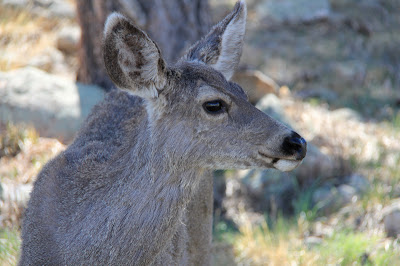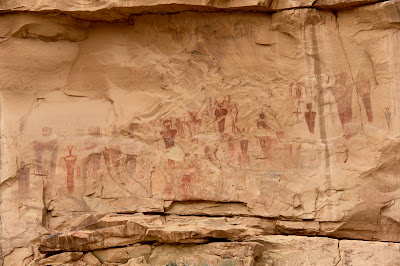Distance: 3 miles round trip
Elevation: 4,280 ft - 4,815 ft
Elevation Gain: 601 ft (cumulative)
Dogs: Not allowed
Bathroom at Trailhead: Yes
Water at Trailhead: No
 |
| The world famous Delicate Arch in Arches National Park. |
Delicate Arch is a superstar destination that half the world can recognize. It is the centerfold in many a landscape calendar and it seems like every professional photographer has a shot in their portfolio. It was Delicate Arch that drew me to Arches National Park. Its ubiquitous image was taunting me. Here this place was, only 5 hours away and I had never seen it.
 |
| The trailhead |
 |
| Blow up this picture and you will see the trail wind through the desert and up to the sloping slickrock face in the distance. |
There are several places where you can view Delicate Arch from a great distance. Both of these spots require that you drive by the main trailhead. I did this early in the morning on my way to
Double Arch and
the Windows. The view reminded me of pictures of the Klondike Gold Rush with a continuous line of hikers...buttocks to buttocks winding up a long slab of slickrock. The prospect was not appealing. Fortunately, by the time I returned in the late afternoon, the crowds had diminished.
 |
| Heading up the slickrock hill |
Delicate Arch was the last hike on my hiking marathon and I was tired and grumpy. I had planned it this way however, knowing that there was no way I would bail on this trail. I wolfed down a couple of chocolate chip cookies I had saved and started up the trail just in time to join a group of bikers who did not look like they walked from their bikes to the nearest bar let alone up a trail. As tired as I was I WAS NOT about to let this group of strollers beat me up the hill. There were no worries there, I passed them in the first quarter mile and did not see them again.
 |
| Unless there is a blizzard blowing, you will not be alone on the Delicate Arch trail. |
The initial part of the trail winds steeply up a wide dirt road that switchbacks several times before transitioning to the tall slickrock hill. It was here that I met a woman in high heel shoes. Her perfectly painted toenails were visible in the open toe and she was dressed for an evening out in South Beach. I goggled aghast. "Did you do this trail in those shoes?" I could not help but ask. She smiled proudly and said yes. It was not their plan but they had just kept going. "You go girl!" I exclaimed in amazement as her Cuban night club owner of a husband beamed and jiggled his gold chains. Don't try this at home children, she is lucky she did not break a leg. The sandstone face is steep.
 |
| After the slickrock hill, the route travels through this gully en route to the hoodoos in the distance. |
There really is no required route up the face, but it obvious where the millions have gone before. Like the ruts of wagons still visible along the Oregon Trail, the soft rock is being worn down bit by bit and a smooth if not indented pathway is clearly visible.
At the top of the slickrock hill, the route curves to the left and winds between a series of hoodoos and Utah Junipers. It is worth while pausing here to look back toward the trailhead and the surrounding canyons. The trailhead is just a dot now.
 |
| The approach to the hoodoos is across another sandstone plateau. Note the cairns heading off into the distance. |
 |
| A more imaginative cairn. The initial sandstone bench is just ahead. |
Past the hoodoos, the trail climbs up onto a slickrock bench. The ascent has been carved into the rock but the bench itself is slightly sloped. I ended up walking along the upper side of it, which was not a good choice. Keep to the lower side even though it is closer to the edge.
This bench quickly becomes a superhighway carved into the rock. This section is relatively wide but does travel along a sheer 1000 foot drop off. Everyone hugs the inner wall, which means continuous games of chicken as hikers fight to retain the inside lane.
 |
| Rock steps up to the bench |
 |
| The rock superhighway. It leans into the cliff instead of into the drop off so no counseling required after passage. |
This rock superhighway is blessedly short but does weave and curve a bit. At the end, the rock face suddenly peels away like the sliding of a closet door to reveal the arch. It is so unexpected and so huge that it is shock to the senses. It takes a second for the arch to retreat across the wild bowl it accents. There is an area of wide flat rocks to lean again on this side of the bowl and most people lunge forward and grasp them gratefully.
 |
| The iconic composition of Delicate Arch with the La Sal Mountains framed by the arch itself. |
 |
| The sandstone bowl is very steep. No one was heading down into it. |
After breathing in the view for a while, I grabbed the camera and ventured to the other side of the bowl. This spot is an amphitheater for the Nature's spirits and waifs. You can sense they gather there in the dark of the night and during storms that keep prying eyes away.
Sunset is the best time to photograph Delicate Arch, but I decided not to wait nor bring my tripod. The reality is that I am a hiker who takes photographs rather than a photographer who hikes. Still, by waiting until late afternoon, I did manage to avoid the crowds and get a little light reflecting off the stone.
 |
| The arch from another angle |
 |
| The arch is out of view to the right. This is the view into the valley below. Most people forget to admire the desert around the arch, but it has beauty too. |
Delicate Arch is one of Mother Nature's wonders, so if you are in the area, don't hesitate to pop into the park and join the hordes on this trail. Most people, even the unfit, can manage to struggle up the hill to view this marvel. Just leave the high heels at home.





















































